AEG LAV88739WB-W, LAV88730-W, LAV88739-W, LAV87739-W Manual
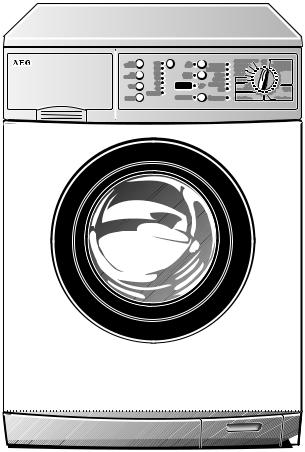
ÖKO-LAVAMAT 88730 update
The environmentally friendly washing machine
User information

Dear Customer,
Please read this instruction book carefully before using the appliance. Please ensure you fully understand the safety instructions on the first pages of this instruction book.
Retain the instruction book for future reference, and pass it on to any future owners.
1 The warning triangle and / or key words (Warning!, Caution!, Important!) give information that is important for your safety or the function of the appliance is highlighted. It is imperative that this information is observed.
01. This symbol guides you step by step through the operation of the appliance.
|
2. ... |
3 |
This symbol gives you additional information and practical tips on using |
|
the appliance. |
2 |
Tips and information about the economical and environmentally |
|
friendly use of the machine are marked with the clover leaf. |
In the event of a malfunction, these operating instructions contain information on how to remedy these faults yourself. See the section "What to do if ..."
Printed on recycled paper.
Thinking ecologically means acting ecologically ...
2

Contents |
|
Operating Instructions . . . . . . . . . . . . . . . . . . . . . . . . . . . . . . . . . . . . |
6 |
Safety . . . . . . . . . . . . . . . . . . . . . . . . . . . . . . . . . . . . . . . . . . . . . . . . . . . . . . . . |
6 |
Disposal . . . . . . . . . . . . . . . . . . . . . . . . . . . . . . . . . . . . . . . . . . . . . . . . . . . . . . |
8 |
Environmental tips . . . . . . . . . . . . . . . . . . . . . . . . . . . . . . . . . . . . . . . . . . . . . |
8 |
Description of the Appliance . . . . . . . . . . . . . . . . . . . . . . . . . . . . . . . . . . . . |
9 |
Front view . . . . . . . . . . . . . . . . . . . . . . . . . . . . . . . . . . . . . . . . . . . . . . . . . . . . |
9 |
Detergent dispenser drawer . . . . . . . . . . . . . . . . . . . . . . . . . . . . . . . . . . . . |
9 |
Control panel . . . . . . . . . . . . . . . . . . . . . . . . . . . . . . . . . . . . . . . . . . . . . . . . . . |
10 |
Programme selector . . . . . . . . . . . . . . . . . . . . . . . . . . . . . . . . . . . . . . . . . . |
10 |
Programme option buttons . . . . . . . . . . . . . . . . . . . . . . . . . . . . . . . . . . . . |
12 |
Consumption data and wash times . . . . . . . . . . . . . . . . . . . . . . . . . . . . . . |
13 |
Run time display . . . . . . . . . . . . . . . . . . . . . . . . . . . . . . . . . . . . . . . . . . . . . . . |
13 |
What does UPDATE mean? . . . . . . . . . . . . . . . . . . . . . . . . . . . . . . . . . . . . . |
14 |
Anti-flood Aqua Control + Aqua Alarm . . . . . . . . . . . . . . . . . . . . . . . . . . |
14 |
Before the first wash . . . . . . . . . . . . . . . . . . . . . . . . . . . . . . . . . . . . . . . . . . |
15 |
Preparing a Wash Load . . . . . . . . . . . . . . . . . . . . . . . . . . . . . . . . . . . . . . . . . |
15 |
Sorting and preparing a wash load . . . . . . . . . . . . . . . . . . . . . . . . . . . . . . . . |
15 |
Washing Types and Care Symbols . . . . . . . . . . . . . . . . . . . . . . . . . . . . . . . . . |
16 |
Detergents and Conditioners . . . . . . . . . . . . . . . . . . . . . . . . . . . . . . . . . . . . . |
17 |
Which detergent and conditioner? . . . . . . . . . . . . . . . . . . . . . . . . . . . . . |
17 |
How much detergent and conditioner? . . . . . . . . . . . . . . . . . . . . . . . . . |
17 |
Water softening . . . . . . . . . . . . . . . . . . . . . . . . . . . . . . . . . . . . . . . . . . . . . . . . |
17 |
Running a washing cycle . . . . . . . . . . . . . . . . . . . . . . . . . . . . . . . . . . . . . . . |
18 |
Brief instructions . . . . . . . . . . . . . . . . . . . . . . . . . . . . . . . . . . . . . . . . . . . . . . . |
18 |
Setting the Washing Programme . . . . . . . . . . . . . . . . . . . . . . . . . . . . . . . . . . |
19 |
Changing the spin speed/Selecting Rinse Hold . . . . . . . . . . . . . . . . . . . . . . |
20 |
Setting the delay timer/soaking duration . . . . . . . . . . . . . . . . . . . . . . . . . . . |
20 |
Opening and closing the door . . . . . . . . . . . . . . . . . . . . . . . . . . . . . . . . . . . . |
21 |
Load the washing . . . . . . . . . . . . . . . . . . . . . . . . . . . . . . . . . . . . . . . . . . . . . . . |
21 |
Add detergent / conditioner . . . . . . . . . . . . . . . . . . . . . . . . . . . . . . . . . . . . . |
22 |
Start the washing programme . . . . . . . . . . . . . . . . . . . . . . . . . . . . . . . . . . . . |
23 |
Washing Programme Progress . . . . . . . . . . . . . . . . . . . . . . . . . . . . . . . . . . . . |
24 |
Washing cycle complete/Removing the washing . . . . . . . . . . . . . . . . . . . . |
25 |
3

Programme tables . . . . . . . . . . . . . . . . . . . . . . . . . . . . . . . . . . . . . . . . . . . . . |
26 |
Washing . . . . . . . . . . . . . . . . . . . . . . . . . . . . . . . . . . . . . . . . . . . . . . . . . . . . . . |
26 |
Separate rinse/conditioning/starching . . . . . . . . . . . . . . . . . . . . . . . . . . . . |
27 |
Separate spin . . . . . . . . . . . . . . . . . . . . . . . . . . . . . . . . . . . . . . . . . . . . . . . . . . |
27 |
Maintenance and Cleaning . . . . . . . . . . . . . . . . . . . . . . . . . . . . . . . . . . . . . |
28 |
Control panel . . . . . . . . . . . . . . . . . . . . . . . . . . . . . . . . . . . . . . . . . . . . . . . . . . |
28 |
Detergent Dispenser Drawer . . . . . . . . . . . . . . . . . . . . . . . . . . . . . . . . . . . . . . |
28 |
Washing Machine Drum . . . . . . . . . . . . . . . . . . . . . . . . . . . . . . . . . . . . . . . . . |
29 |
Main door . . . . . . . . . . . . . . . . . . . . . . . . . . . . . . . . . . . . . . . . . . . . . . . . . . . . . |
29 |
Cleaning the drain pump . . . . . . . . . . . . . . . . . . . . . . . . . . . . . . . . . . . . . . . . |
30 |
What to do if... . . . . . . . . . . . . . . . . . . . . . . . . . . . . . . . . . . . . . . . . . . . . . . . . |
31 |
Trouble Shooting . . . . . . . . . . . . . . . . . . . . . . . . . . . . . . . . . . . . . . . . . . . . . . . |
31 |
If the washing results are not satisfactory . . . . . . . . . . . . . . . . . . . . . . . . . . |
34 |
Carrying out an emergency emptying . . . . . . . . . . . . . . . . . . . . . . . . . . . . . . |
35 |
Emergency unlocking of the door . . . . . . . . . . . . . . . . . . . . . . . . . . . . . . . . . |
36 |
Additional Rinse (RINSE+) . . . . . . . . . . . . . . . . . . . . . . . . . . . . . . . . . . . . . . . . |
37 |
Water Cooling . . . . . . . . . . . . . . . . . . . . . . . . . . . . . . . . . . . . . . . . . . . . . . . . . |
38 |
Additional Rinse and Water Cooling . . . . . . . . . . . . . . . . . . . . . . . . . . . . . . . |
38 |
Programme protection . . . . . . . . . . . . . . . . . . . . . . . . . . . . . . . . . . . . . . . . . |
39 |
Child Safety Feature . . . . . . . . . . . . . . . . . . . . . . . . . . . . . . . . . . . . . . . . . . . |
40 |
Installation and connection instructions . . . . . . . . . . . . . . . . |
41 |
Installation Safety Precautions . . . . . . . . . . . . . . . . . . . . . . . . . . . . . . . . . . |
41 |
Installation of the appliance . . . . . . . . . . . . . . . . . . . . . . . . . . . . . . . . . . . . |
42 |
Transporting the appliance . . . . . . . . . . . . . . . . . . . . . . . . . . . . . . . . . . . . . . . |
42 |
Remove transport packaging . . . . . . . . . . . . . . . . . . . . . . . . . . . . . . . . . . . . . |
42 |
Installation-Site preparation . . . . . . . . . . . . . . . . . . . . . . . . . . . . . . . . . . . . . |
44 |
Installation on a Suspended Floor . . . . . . . . . . . . . . . . . . . . . . . . . . . . . . . . . |
44 |
Levelling the appliance . . . . . . . . . . . . . . . . . . . . . . . . . . . . . . . . . . . . . . . . . . |
45 |
4

Electrical Connection . . . . . . . . . . . . . . . . . . . . . . . . . . . . . . . . . . . . . . . . . . |
46 |
Water connection . . . . . . . . . . . . . . . . . . . . . . . . . . . . . . . . . . . . . . . . . . . . . |
48 |
Water pressure . . . . . . . . . . . . . . . . . . . . . . . . . . . . . . . . . . . . . . . . . . . . . . . . . |
48 |
Inlet Hose Connection . . . . . . . . . . . . . . . . . . . . . . . . . . . . . . . . . . . . . . . . . . . |
49 |
Water Drainage . . . . . . . . . . . . . . . . . . . . . . . . . . . . . . . . . . . . . . . . . . . . . . . . |
50 |
Pump head of greater than 1m . . . . . . . . . . . . . . . . . . . . . . . . . . . . . . . . . . . |
51 |
Technical data . . . . . . . . . . . . . . . . . . . . . . . . . . . . . . . . . . . . . . . . . . . . . . . . |
52 |
Dimensions . . . . . . . . . . . . . . . . . . . . . . . . . . . . . . . . . . . . . . . . . . . . . . . . . . |
52 |
Warranty conditions . . . . . . . . . . . . . . . . . . . . . . . . . . . . . . . . . . . . . . |
53 |
Index . . . . . . . . . . . . . . . . . . . . . . . . . . . . . . . . . . . . . . . . . . . . . . . . . . . . . . . . |
54 |
Service & Spare Parts . . . . . . . . . . . . . . . . . . . . . . . . . . . . . . . . . . . . . |
55 |
5

Operating Instructions
Operating Instructions
1 Safety
The safety features of AEG electrical appliances comply with accepted technical standards and the German Appliance Safety Law. However, we also consider it our obligation as a manufacturer to inform you about the following safety information.
Prior to initial start-up
•Observe the "Installation and Connection Instructions" in this instruction book.
•If the appliance is delivered in the winter months and temperatures are below freezing: Store the washing machine at room temperature for a few hours before putting it into operation.
Intended Use
•The washing machine is only intended for washing normal domestic washing. If the appliance is used for any other purpose or incorrectly operated, the manufacturer accepts no liability for any damages which may result.
•It is dangerous to alter the specifications or attempt to modify this product in any way.
•Only use detergents which are suitable for automatic washing machines, and follow the recommendations of the detergent manufacturer.
•Garments which have been in contact with flammable solvents should not be washed. Also bear this in mind when washing precleaned washing.
•Do not use the washing machine for dry-cleaning.
•Dyes and bleaching agents may only be used if specifically permitted by the manufacturer of these products. We cannot be held liable for any damages.
•This appliance must be connected to the cold water supply only.
•Damage due to frost is not covered by the guarantee. If the washing machine is located in a room in which below freezing temperatures may occur, emergency emptying must be carried out (see "carrying out an emergency emptying“).
6

Operating Instructions
Child Safety
•Packaging materials (e.g. films, styrofoam) can be dangerous for children. There is a risk of suffocation! Keep all packaging well away from children.
•This appliance is designed to be operated by adults. Do not allow children to tamper with the controls or play with the appliance.
•Pets and children have been known to climb into washing machines. Please check the drum before use.
•When disposing of the appliance, cut off the mains cable, and destroy the plug. Disable the door lock to prevent young children being trapped inside.
General Safety
•Repairs to the washing machine must only be carried out by qualified personnel. Repairs carried out by inexperienced persons may cause injury or serious malfunctioning. Contact your local AEG Service Force Centre.
•Never operate the washing machine if the mains cable is damaged or the control panel, work top or base area are damaged allowing internal components to be accessible.
•Switch off the appliance and isolate from the mains supply before carrying out any cleaning or maintenance work.
•If the appliance will be out of operation for an extended period of time, unplug it from the mains.
•Do not use the mains cable to pull the plug out of the socket.
•Adapters and extension cables must not be used. There is a danger of overheating!
•Do not clean the washing machine with a water jet. There is a danger of electrical shock!
•During high temperature wash programmes, the glass of the door may become hot. Do not touch!
•Allow the water to cool down before cleaning the drain pump, carrying out emergency emptying or opening the door in an emergency.
•Small animals/pets can chew on power cables and water hoses. This can cause the danger of an electrical shock to the animal and water damage to the appliance and property. Keep small animals away from the appliance.
7

Operating Instructions
2 Disposal
Packaging
Dispose of the packaging material correctly. All packaging materials used are environmentally friendly and can be disposed of without any danger to the environment.
• Plastic parts can be recycled and are identified as follows:
>PE< |
for polyethylene, e.g. the outer covering and the bags in |
|
the interior. |
||
|
||
>PS< |
for polystyrene, e.g. padding (always CFC-free) |
|
>POM< |
for polyoxymethylene, e.g. plastic clips |
•Cardboard packaging is manufactured from recycled paper and should be deposited in the waste paper collection for recycling.
When disposing of the washing machine!
Cut off the mains cable and destroy the plug. Disable the door catch to prevent young children becoming trapped inside. Use an authorised disposal site.
2 Environmental tips
To save water and energy, and to help protect the environment, we recommend that you follow these tips.
•Do not use a pre-wash for normally soiled washing.
•It is more economical to wash full loads.
•When washing small loads, reduce the detergent by half to two thirds.
•Pre-treat stains, and then wash at a lower temperature.
•Use the energy-saving programme when washing light to normally soiled garments.
•In hard water areas, the use of a water softening agent can reduce the amount of detergent necessary. See manufacturers recommendations.
8
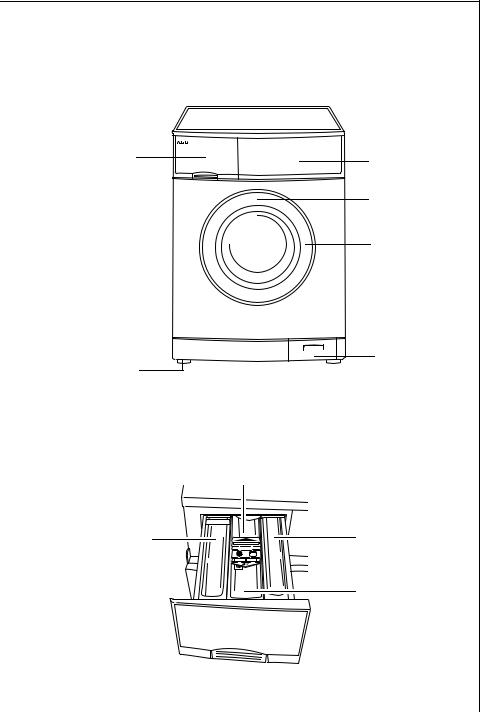
Operating Instructions
Description of the Appliance
Front view
Detergent |
Control panel |
dispenser drawer |
Rating plate (behind door)
Main door
Screw feet (height- |
|
|
adjustable); |
Flap in front of |
|
rear left: Automatic |
||
drain pump |
||
adjustment foot |
||
|
Detergent dispenser drawer
Stain removers
Main wash detergent in powder form and water softening agent if required
Pre-wash detergent/ soaking agent or water softening agent if used
Liquid conditioners (fabric softener, starch)
9
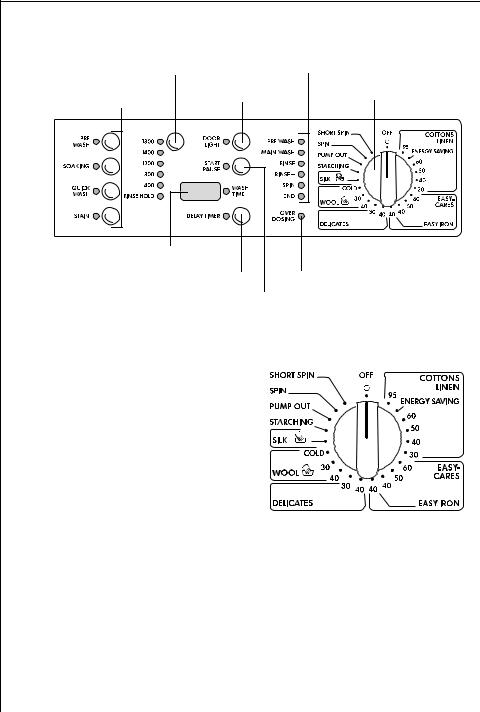
Operating Instructions
Control panel
Spin speed / RINSE HOLD button
Programme option buttons
Programme progress display
Programme selector
Multi-display
DELAY TIMER button |
OVER DOSING indicator |
START/PAUSE button
|
Programme selector |
|
The programme selector defines |
|
the nature of the washing cycle |
|
(e.g. water level, drum move- |
|
ment, number of rinses, spin |
|
speed) to suit the type of wash- |
|
ing, as well as the wash tempera- |
|
ture. |
|
OFF |
|
Switches the washing machine |
|
off, the machine is switched on |
|
at all other positions. |
|
COTTONS/LINEN |
|
Main washing cycle Cottons / Linen (Cottons / Linen) at 30 °C to 95 °C. |
2 |
ENERGY SAVING position: Energy-saving programme at approximately |
|
67 °C for lightly to normally soiled cottons, extended washing time |
(cannot be combined with QUICK WASH and STAIN)
10

Operating Instructions
EASY-CARES
Main washing cycle for easy-care textiles (mixed fabrics) at 40 °C to 60 °C.
EASY IRON position: Main washing cycle at 40 °C for easy-care fabrics which, with the aid of this programme, only require a gentle iron, if any ironing at all.
DELICATES
Main washing cycle for delicates at 30 °C or 40 °C.
WOOLLENS / P (hand wash)
Washing cycle (cold up to 40 °C) for machine-washable woollens and for hand-washable woollen fabrics with the care symbol ï(hand wash).
SILK / P (hand wash)
Main washing cycle 30 °C for hand-washable and machine-washable silk.
3 As silk is a very sensitive fabric, we recommend that you only wash one item of clothing at a time, and that such items never be washed with other rough fabrics. A very gentle wash is possible using the QUICK WASH button for extremely sensitive silk fabrics.
STARCHING
Separate starching, separate softening, separate conditioning of wet washing (one rinse cycle, liquid conditioner is washed in from the æ compartment, and a spin - max. spin 1800 rpm).
If a separate rinse cycle is required, this can be carried out by omitting the conditioner from the æcompartment.
PUMP OUT
Pumping out the water after a rinse hold (without spinning).
3 Rinse hold means the washing remains in the last rinsing water and is not spun.
SPIN
Pumping out the water after a rinse hold and spinning, or separate spinning of hand-washed cottons/linen (max. spin 1200 rpm).
SHORT SPIN
Pumping out the water at the end of a rinse hold and short spin, or separate short spin for delicate fabrics (easy-care washing, delicates, wool).
11
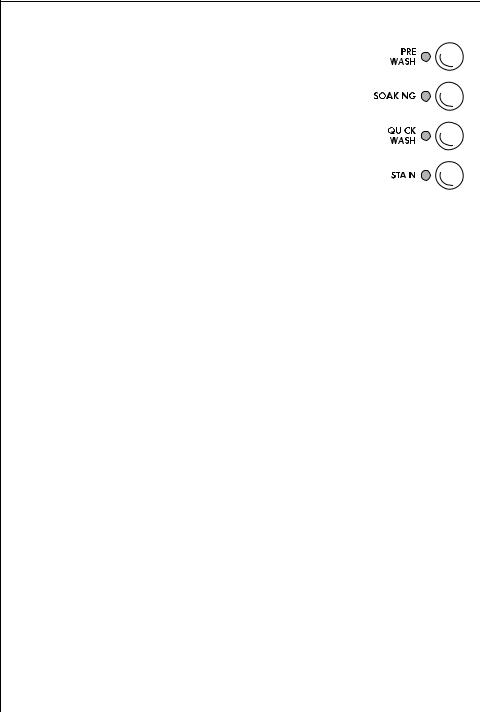
Operating Instructions
|
Programme option buttons |
||||||
|
The programme option buttons are used to adapt |
||||||
|
the washing programme to suit the degree of |
||||||
|
soiling of the washing. Programme options are not |
||||||
|
required for normally soiled washing. |
|
|
|
|
||
|
|
||||||
|
|
||||||
|
The different functions can be combined together |
||||||
|
depending on the programme. |
|
|
|
|
||
|
|
||||||
|
PRE WASH |
||||||
|
You can select the pre-wash before the main wash |
||||||
|
on the following programmes: COTTONS / LINEN, |
|
|
||||
|
|
||||||
|
EASY CARE and DELICATES. There is a short spin be- |
||||||
|
tween the pre-wash and the COTTONS / LINEN |
||||||
|
main wash. |
||||||
|
The EASY CARE and DELICATES main wash follow |
||||||
|
the pre-wash without a spin. |
||||||
|
SOAKING |
||||||
|
Approx. 1 hour at 30 °C or 40 °C depending upon the wash programme |
||||||
|
set. Can be extended to a maximum of 19 hours with the DELAY TIMER |
||||||
|
button. The main washing programme then follows automatically. |
||||||
|
QUICK WASH |
||||||
|
Short main washing cycle for lightly soiled washing. |
||||||
|
STAINS |
||||||
|
For treating heavily soiled washing or stained washing. (In-wash stain |
||||||
|
treatment is washed in from the æcompartment at the optimal part in |
||||||
|
the programme cycle.) |
||||||
3 |
When the WOOLLENS /P(hand washing) setting is chosen, the pro- |
||||||
|
gramme options cannot be selected (any buttons pressed have no ef- |
||||||
fect).
12
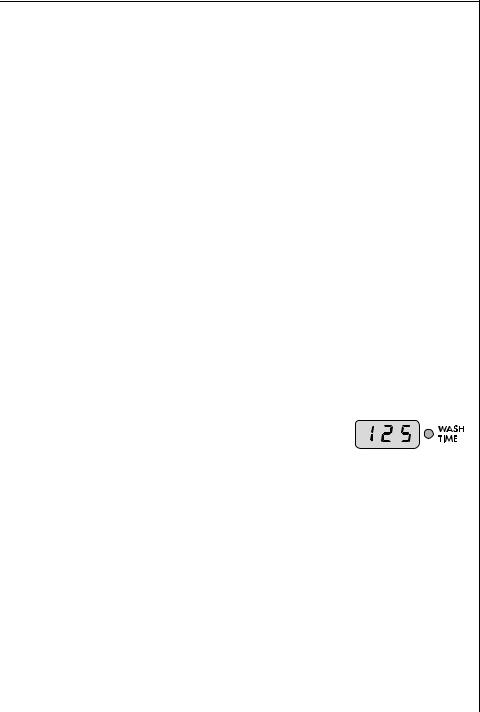
Operating Instructions
Consumption data and wash times
The values given in the following table for selected programmes were calculated under standard conditions. They provide a useful guide for operation in the home.
Programme selector/ |
Load in kg |
Water |
Energy |
Time in |
|
temperature |
in litres |
in kWh |
minutes |
||
|
|||||
COTTONS/LINEN 95 |
5 |
39 |
1.65 |
137 |
|
COTTONS-/LINEN 60 1) |
5 |
39 |
0.89 |
125 |
|
COTTONS-/LINEN 40 |
5 |
44 |
0.55 |
122 |
|
EASY-CARES 40 |
2.5 |
45 |
0.42 |
102 |
|
DELICATES 30 |
2.5 |
49 |
0.40 |
68 |
|
WOOLLENS/ P(hand wash) 30 |
2 |
42 |
0.20 |
37 |
|
|
|
|
|
|
1)Note: The selected programme is tested in accordance with EN 60 456. The consumption values, however, can deviate depending on the following: water pressure, water hardness, water inlet temperature, room temperature, washing type and washing quantity, the detergent used, and the selected programme options.
Run time display
3 The multi-display indicates the estimated duration, in minutes, of the programme. These timings are estimates and vary.
During the programme countdown the remain-
ing time can be recalculated due to any of the following: incoming water temperature, type and quantity of laundry, out of balance spin detection and foam detection.
13

Operating Instructions
What does UPDATE mean?
The control system of your machine is fully electronic. The software which determines this control system can be reprogrammed. If a further improvement to washing technology is introduced by AEG then your machine can be updated.
The cost of the update will be advised at the time of the request. For further information regarding this please contact the AEG Customer Care Department.
Anti-flood Aqua Control + Aqua Alarm
The inlet hose has a mechanical built in safety device. In the event of the filling hose failing, the safety device will automatically shut off the water supply.
In the event of a leak within the machine the float switch, which is mounted in the base of the appliance, will operate the drain pump and an audible signal will be heard
The system will operate as long as the appliance is connected to the mains electricity supply, even if the programme selector is in the off position.
14

Operating Instructions
Before the first wash
0Run a washing cycle without washing (COTTONS 95, with half the amount of detergent).
This removes any residues from the drum which may have been left during manufacturing.
Preparing a Wash Load
Sorting and preparing a wash load
•Sort washing according to the care symbol and type (see "Washing types and care symbols").
•Empty all pockets.
•Remove metal objects (paper clips, safety pins etc.).
•In order to prevent bunching up of washing and damage to washing, close zippers, button up duvet covers and pillow cases, and tie up loose straps such as from aprons.
•Turn articles with double layered textiles inside out (sleeping bags, anoraks etc.).
•Coloured, knitted fabrics, as well as wool and fabrics with appliqués should be turned inside out.
•Place small and delicate items (e.g. socks, tights and stockings, bras etc.) in a washing net, or pillow case.
•Handle curtains with care. Metal rollers or burred, plastic rollers must be removed or tied into a net or bag. We cannot accept liability for damage.
•Do not wash coloured and white washing together. This could discolour white washing or turn it grey.
•New, coloured washing often contains excessive dye. Wash these separately the first time.
•Mix small and large items of washing. This improves washing efficiency and the washing is more evenly distributed during the spinning cycle.
•Shake out washing before placing into the washing machine.
•Do not place folded washing into the drum.
•Observe tips such as "wash separately“ and "wash separately several times".
15

Operating Instructions
Washing Types and Care Symbols
The care symbols help you choose the correct washing programme. Washing should be sorted according to type and care symbol. The temperatures indicated in the care symbols are maximum values.
Cottons ç
Fabrics made from cotton and linen with this care symbol will withstand maximum wash actions and high temperatures. The programme COTTONS/LINEN is appropriate for this type of washing.
Linens è ë
Fabrics made from cottons and linens with this care symbol will withstand maximum wash actions. The programme COTTONS/LINEN is appropriate for this type of washing.
Easy-care washing ê í
Fabrics such as treated cotton, cotton mixed fabrics, viscose and synthetics with this care symbol require chemically more gentle treatment. The programme EASY CARES/EASY IRON is suitable for this type of washing.
Delicates ì
Fabrics such as those with layered fibres, micro fibres, viscose, as well as synthetics and Curtains with this care symbol require particularly careful handling. The DELICATES programme is suitable for this type of washing.
Wool, silk and particularly sensitive washing 9 ì ï
Fabrics such as wool, wool mixtures and silk which carry this care symbol are particularly sensitive to mechanical stress. The programmes WOOLLENS /P(hand wash) and SILK/P(hand wash) are suitable for this type of fabric.
Important! Fabrics with this care symbol ñ(do not wash) must not be washed in the washing machines.
16

Operating Instructions
Detergents and Conditioners
Which detergent and conditioner?
Use only detergents and conditioners which are suitable for use in automatic washing machines. Always follow the manufacturer's instructions.
|
How much detergent and conditioner? |
|
The required quantity depends upon: |
|
• the extent of soiling of the washing |
|
• the hardness class of the mains water |
|
• the amount of washing |
2 |
Should the detergent manufacturer not specify the dosage quantity for |
|
less than full loads, reduce the detergent accordingly: For a half load |
reduce the quantity by 1/3. For a small load or an EASY IRON programme reduce the quantity by 1/2.
Observe the instructions for use and dosing provided by the detergent and conditioner manufacturer.
Water softening
For medium to high water hardness (hardness class II upwards) a water softening agent can be used. Refer to the manufacturer's instructions. Then always add the appropriate amount of detergent (underdosing) for hardness class I (soft). Your local Water Authority can advise you on the hardness of the water in your area.
Water hardness details
Hardness class |
Water hardness in °dH |
Water hardness in ppm |
||
(German hardness scale) |
(Parts Per Million) |
|||
|
||||
I - soft |
0 - 7 |
to |
125 |
|
II - medium hard |
7 - 14 |
125 |
- 250 |
|
III - hard |
14 - 21 |
250 |
- 375 |
|
IV - very hard |
greater than 21 |
greater than 375 |
||
|
|
|
|
|
17
